
Leccinum manzanitae is an edible species of bolete fungus in the family Boletaceae. Described as new to science in 1971, it is commonly known as the manzanita bolete for its usual mycorrhizal association with manzanita trees. Its fruit bodies (mushrooms) have sticky reddish to brown caps up to 20 cm (8 in), and its stipes are up to 16 cm (6.3 in) long and 3.5 cm (1.4 in) thick. They have a whitish background color punctuated with small black scales known as scabers. Found only in the Pacific Northwest region of the United States and Canada, it is the most common Leccinum species in California. The mushroom is edible, although opinions vary as to its quality. L. manzanitae can be usually distinguished from other similar bolete mushrooms by its large size, reddish cap, dark scabers on a whitish stipe, and association with manzanita and madrone.

Xerocomellus zelleri, commonly known as Zeller's bolete, is an edible species of mushroom in the family Boletaceae. First described scientifically by American mycologist William Alphonso Murrill in 1912, the species has been juggled by various authors to several genera, including Boletus, Boletellus, and Xerocomus. Found solely in western North America from British Columbia south to Mexico, the fruit bodies are distinguished by their dark reddish brown to nearly black caps with uneven surfaces, the yellow pores on the underside of the caps, and the red-streaked yellow stems. The fungus grows in summer and autumn on the ground, often in Douglas fir forests or on their margins. The development of the fruit bodies is gymnocarpic, meaning that the hymenium appears and develops to maturity in an exposed state, not enclosed by any protective membrane.
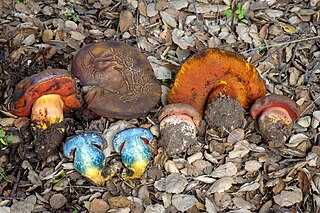
Suillellus amygdalinus is a fungus of the bolete family found in western North America. The fruit bodies, or mushrooms, are characterized by their thick, red to brown caps, red pores, and the strong bluing reaction observed when the mushroom tissue is injured or cut. The cap can reach diameters of up to 12 cm (4.7 in) and the stipe 9 cm (3.5 in) long by 3 cm (1.2 in) thick at maturity. This mushroom has been found in manzanita and madrone woodlands of central California north to southern Oregon. Although the edibility of the mushroom is not known with certainty, it may be poisonous, and is not recommended for consumption. Other similar red-pored, bluing boletes from North America, including Rubroboletus eastwoodiae, Boletus luridiformis, and B. subvelutipes, can be distinguished from S. amygdalinus either by the color of the cap, the degree of reticulation on the stipe, or by location.

Caloboletus rubripes, commonly known as the red-stipe bolete or the red-stemmed bitter bolete, is a mushroom in the family Boletaceae. It was known as Boletus rubripes until 2014. Fruit bodies (mushrooms) are robust, with caps up to 18 cm in diameter, atop thick stipes 5–12 cm long. Mushrooms are non-toxic, but is so bitter as to be inedible. The mushroom flesh has a very strong bluing reaction when cut or damaged. and forms mycorrhizal relationships, primarily with conifers. It can be differentiated from similar boletes by its cap color and non-reticulate stipe.
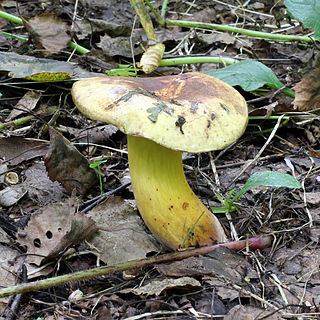
Cyanoboletus pulverulentus, commonly known as the ink stain bolete, is an edible bolete mushroom. It is found in deciduous and mixed forests, particularly on moist soil on slopes and under beech and oak trees. A common species, it is found in northern Asia, Europe, North Africa, Central and northern South America, and eastern North America. All parts of the mushroom will stain dark bluish-black after handling. A recent study has revealed this mushroom hyperaccumulates arsenic and therefore it's consumption should be limited.
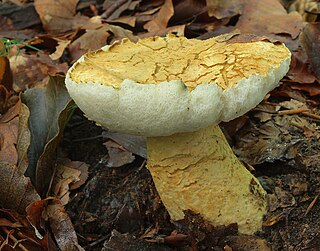
Gyroporus cyanescens, commonly known as the bluing bolete or the cornflower bolete, is a species of bolete fungus in the family Gyroporaceae. First described from France in 1788, the species is found in Asia, Australia, Europe, and eastern North America, where it grows on the ground in coniferous and mixed forests.

Tylopilus tabacinus is a species of bolete fungus in the family Boletaceae. It is characterized by a tawny-brown cap measuring up to 17.5 cm (6.9 in) in diameter, and a reticulated stem up to 16.5 cm (6.5 in) long by 6 cm (2.4 in) thick. A characteristic microscopic feature is the distinctive crystalline substance encrusted on the hyphae in the surface of the cap. The species is known from the eastern United States from Florida north to Rhode Island, and west to Mississippi, and from eastern Mexico. It is a mycorrhizal species, and associates with oak and beech trees.

Tylopilus alboater, called the black velvet bolete, by some, is a bolete fungus in the family Boletaceae. The species is found in North America east of the Rocky Mountains, and in eastern Asia, including China, Japan, Taiwan, and Thailand. A mycorrhizal species, it grows solitarily, scattered, or in groups on the ground usually under deciduous trees, particularly oak, although it has been recorded from deciduous, coniferous, and mixed forests.
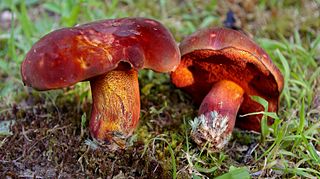
Boletus rubroflammeus is a species of bolete fungus in the family Boletaceae. First described from Michigan in 1971, it is found in the eastern United States and Mexico, where it grows in a mycorrhizal association with hardwood trees. The fruit bodies (mushrooms) of the fungus have caps that are deep red to purplish red, and dark red pores. The stem has coarse, dark red reticulations and a narrow yellow area at the top. All parts of the mushroom quickly stain blue when injured or cut. Lookalikes include Boletus flammans, a lighter-colored species that grows with conifers. Other similar species can be distinguished by differences in distribution, morphology, staining reaction, and microscopic characteristics. Boletus rubroflammeus mushrooms are poisonous, and can cause gastrointestinal distress if consumed.

Boletus abruptibulbus is a species of bolete mushroom in the family Boletaceae. Described as new to science in 2009, it is found only in the Gulf Coast of the Florida Panhandle, where it grows on the ground in coastal sand dunes, one of only three North American boletes known to favor this habitat. The fruit bodies have convex brownish caps up to 8 cm (3.1 in) in diameter, supported by solid yellowish to reddish stems measuring 3–5 cm (1.2–2.0 in) long by 10–15 mm (0.4–0.6 in) thick. The pores on the underside of the cap measure about 1–2 mm in diameter and are initially pale yellow before developing a greenish tinge in age. The mushroom's spores, about 20 micrometers long, are unusually long for a member of the Boletaceae. The stem base is bulbous, a diagnostic feature for which the species is named.

Phylloporus arenicola is a species of bolete mushroom in the family Boletaceae. It is found in the Pacific Northwest region of western North America, where it grows in sand dunes in a mycorrhizal association with pine trees. It is one of only three North American Boletaceae species that occur in coastal sand dunes.

Aureoboletus auriflammeus, commonly known as the flaming gold bolete, is a species of bolete fungus in the family Boletaceae. Described as new to science in 1872, it is found in eastern North America, where it grows in a mycorrhizal association with oaks. The caps of the fruit bodies are golden orange, with a yellow pore surface on the underside, and a reticulated (network-like) stem. The edibility of the mushroom is not known.

Boletus carminiporus is a species of bolete fungus in the family Boletaceae. Described as new to science in 1998, the species is found in the southern United States where it grows in a mycorrhizal association with various trees in mixed forests.
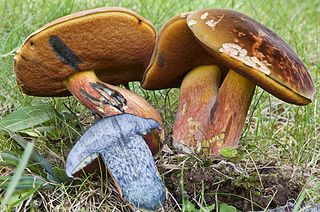
Boletus subvelutipes, commonly known as the red-mouth bolete, is a bolete fungus in the family Boletaceae. It is found in Asia and North America, where it fruits on the ground in a mycorrhizal association with both deciduous and coniferous trees. Its fruit bodies (mushrooms) have a brown to reddish-brown cap, bright yellow cap flesh, and a stem covered by furfuraceous to punctate ornamentation and dark red hairs at the base. Its flesh instantly stains blue when cut, but slowly fades to white. The fruit bodies are poisonous, and produce symptoms of gastrointestinal distress if consumed.

Pulveroboletus ravenelii, commonly known as Ravenel's bolete or the powdery sulfur bolete, is a species of bolete fungus in the family Boletaceae. Described as new to science in 1853, the widely distributed species is known from Asia, Australia, North America, Central America, and South America. Mycorrhizal with oak, the fungus fruits on the ground singly, scattered, or in groups in woods. Fruit bodies (mushrooms) have convex to flat, yellowish to brownish-red caps up to 10 cm (4 in) in diameter. On the cap underside, the pore surface is bright yellow before turning dingy yellow to grayish brown with age; it stains greenish blue then grayish brown after injury. A cottony and powdery partial veil remains as a ring on the stipe. The mushrooms are edible, and have been used in traditional Chinese medicine and for mushroom dyeing.

Harrya chromapes, commonly known as the yellowfoot bolete or the chrome-footed bolete, is a species of bolete fungus in the family Boletaceae. The bolete is found in eastern North America, Costa Rica, and eastern Asia, where it grows on the ground, in a mycorrhizal association with deciduous and coniferous trees. Fruit bodies have smooth, rose-pink caps that are initially convex before flattening out. The pores on the cap undersurface are white, aging to a pale pink as the spores mature. The thick stipe has fine pink or reddish dots (scabers), and is white to pinkish but with a bright yellow base. The mushrooms are edible but are popular with insects, and so they are often infested with maggots.

Tylopilus intermedius, commonly known as the bitter parchment bolete, is a bolete fungus in the family Boletaceae native to the eastern United States.
Tylopilus ammiratii is a fungus of the genus Tylopilus found in California, where it fruits scattered or in groups under black oak. Fruiting occurs from October to December. It was described as new to science by mycologist Harry Delbert Thiers in 1975. The type collection was made in Shasta County in November 1971 by Joseph Ammirati, for whom the species is named.

Sutorius eximius, commonly known as the lilac-brown bolete, is a species of fungus in the family Boletaceae. This bolete produces fruit bodies that are dark purple to chocolate brown in color with a smooth cap, a finely scaly stipe, and a reddish-brown spore print. The tiny pores on the cap underside are chocolate to violet brown. It is widely distributed, having been recorded on North America, South America, and Asia, where it grows in a mycorrhizal relationship with both coniferous and deciduous trees.
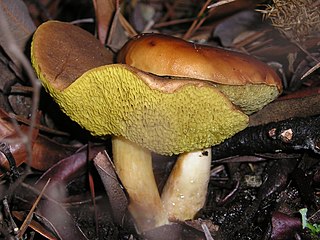
Boletus amyloideus is a rare species of bolete fungus in the family Boletaceae. It was described as new to science in 1975 by mycologist Harry D. Thiers, from collections made in California. It fruit bodies have a convex to somewhat flattened reddish-brown cap measuring 3–6 cm (1.2–2.4 in) in diameter. The pore surface on the cap underside is bright yellow, with small angular pores and tubes measuring 4–8 mm long. The spore print is olive-brown; basidiospores are smooth, amyloid, spindle shaped to ellipsoid, and have dimensions of 13–16 by 4.5–5.5 µm. The bolete is known only from coastal California, where it grows on the ground in mixed forests. Its edibility is unknown.





















